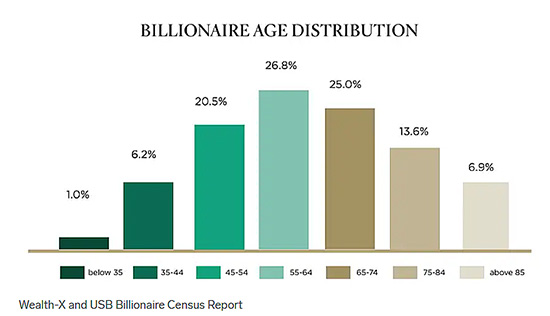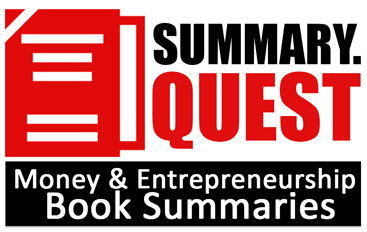In “The Self-made Billionaire Effect” by John Sviokla and Mitch Cohen, you’ll journey into the realm of self-made billionaires who aren’t just amassing wealth but reshaping the game of success. Delving into their secrets, the book reveals that the path from millionaire to billionaire requires more than mere hustle; it demands a unique touch. With insights to spot, cultivate, and perhaps join their ranks, are you prepared to unleash your own extraordinary potential? Let’s embark on this thrilling adventure!
Key Idea No. 1: Misconceptions About Self-Made Billionaires
In a world captivated by the rise of young tech billionaires and the allure of overnight success stories, it’s easy to fall prey to misconceptions about what it takes to join the elite ranks of the ultra-wealthy. However, the reality is quite different. Let’s debunk some of these myths and shed light on the reality of self-made billionaires.

- Most Self-made Billionaires Strike It Rich in Their Twenties: Contrary to popular belief, the journey to billionaire status is often a marathon, not a sprint. While we hear stories of Mark Zuckerberg and other tech wunderkinds hitting it big in their twenties, the truth is that most self-made billionaires don’t achieve their wealth until later in life. So, if you’re feeling like you’re behind schedule, take solace in knowing that success doesn’t adhere to a strict timeline.
- Tech Is the Only Path to Riches: Tech moguls may grab the spotlight, but they represent only a fraction of the billionaire population. Less than 20% of billionaires hail from the tech industry, demonstrating that wealth knows no boundaries when it comes to sectors. From finance to fashion, billionaires emerge from a diverse array of industries, proving that there’s more than one road to prosperity.
- Luck Is the Primary Factor: While luck undoubtedly plays a role in success, it’s not the sole determinant. The vast majority of self-made billionaires didn’t stumble upon one stroke of luck; they had multiple successful ventures. Moreover, many billionaires attribute their success not just to luck but also to hard work, determination, and strategic decision-making.
- Self-made Billionaires Are Cutthroat Business Tycoons: Contrary to popular belief, not all billionaires fit the stereotype of ruthless business magnates. Many of them are committed to philanthropy and giving back to society, with a significant number pledging to donate a substantial portion of their wealth to charitable causes. Their success isn’t solely measured by their financial achievements but also by their impact on the world around them.
- Self-made Billionaires Reinvent Industries: While some self-made billionaires may revolutionize their respective industries, the majority achieve success by innovatively building upon existing concepts. They identify gaps in the market, capitalize on emerging trends, and offer unique solutions to consumer needs. It’s not always about reinventing the wheel but rather about refining and reimagining existing concepts.
- Self-made Billionaires Focus on One Thing: Successful billionaires are masters of integration, seamlessly combining diverse perspectives and strategies to achieve their goals. They understand the importance of diversification, not in spreading themselves thin, but in strategically allocating their resources and efforts across multiple ventures. Their ability to integrate seemingly conflicting ideas and actions sets them apart as “Producers,” capable of envisioning, creating, and delivering value to the market.
The journey to billionaire status is paved with hard work, strategic thinking, and a willingness to challenge conventional wisdom. By dispelling common myths about self-made billionaires, we can gain a clearer understanding of what it truly takes to achieve extraordinary success.
Key Idea No. 2: Success is Not Luck
When we think of self-made billionaires, we often envision extraordinary success stories born from a single stroke of genius or a lucky break. However, the reality is far more nuanced. Behind every billionaire’s journey lies a tapestry of hard work, expertise, and a deep understanding of their field.

Many renowned billionaires, such as Steve Jobs, Bill Gates, or Jack Ma, are celebrated for their groundbreaking ideas that revolutionized industries. Yet, not all billionaires achieve success by creating entirely new concepts. Some, like James Dyson or Chip Wilson, excel in competitive fields by leveraging their creativity and expertise to innovate within established markets.
James Dyson’s reinvention of the vacuum cleaner industry and Chip Wilson’s foresight in combining fabrics with fashion to create Lululemon are prime examples. Their journeys highlight the importance of recognizing and capitalizing on emerging trends, even within saturated markets.

Moreover, the path to billionaire status is rarely without obstacles. Most billionaires encounter failures and setbacks along the way. Chip Wilson faced numerous challenges in his entrepreneurial endeavors, but his deep understanding of his field allowed him to identify and seize opportunities, such as the rising popularity of yoga, which ultimately led to Lululemon’s success.
In essence, the journey to becoming a billionaire is a complex interplay of experience, perseverance, and the ability to spot and capitalize on opportunities. It involves challenging established norms, taking unconventional paths, and, above all, a relentless commitment to one’s vision.
Therefore, while luck is undeniably a crucial factor in the journey to becoming a billionaire, it is not the only one. Expertise, creativity, perseverance, and a keen eye for emerging trends are equally essential. Behind every overnight sensation lies years of hard work, resilience, and a wealth of knowledge. Success, therefore, is not merely about achieving a goal but about the journey, the lessons learned, and the impact made along the way.
Key Idea No. 3: Timing is Everything
In the fast-paced world of business, timing can often be the determining factor between success and failure. It’s not just about being in the right place at the right time; it’s about having the foresight to anticipate market shifts, the adaptability to pivot when necessary, and the patience to wait for the opportune moment to strike. Let’s delve into why timing is so crucial when it comes to achieving immense wealth in business:
- Spotting Trends & Anticipation: Successful businessmen and women have a knack for spotting trends before they become mainstream. They keep a finger on the pulse of the market, constantly gathering information and staying informed about emerging opportunities. By anticipating what’s coming next, they position themselves to capitalize on these trends, turning them into lucrative ventures.
- Adaptability & Flexibility: Adaptability is another key aspect of mastering timing in business. Entrepreneurs must be willing to pivot their strategies, products, and services in response to changing market conditions. This requires flexibility and a willingness to embrace change rather than resist it. Those who can adapt quickly are often the ones who thrive in dynamic business environments.
- The Importance of Patience: While swift action is crucial in seizing opportunities, patience is equally important. Rushing into decisions without careful consideration can lead to costly mistakes. Taking the time to assess risks, gather information, and plan effectively can lead to more successful outcomes in the long run. Patience allows entrepreneurs to wait for the right moment to execute their plans, maximizing their chances of success.
The stories of Sunil Mittal and Steve Case serve as perfect illustrations of the importance of timing in business success. Mittal started his entrepreneurial journey by selling bikes but quickly pivoted to importing generators. When the Indian government banned imported generators, he once again shifted gears and ventured into the telecommunications industry, eventually creating Airtel, one of India’s largest phone companies. Mittal’s ability to adapt to changing circumstances and capitalize on emerging opportunities played a pivotal role in his success.
Similarly, Steve Case, the founder of AOL, recognized the potential of the internet early on but waited for the right moment to launch his business. AOL wasn’t an overnight success; it took years of hard work and perseverance. However, Case was prepared when the internet wave hit, and he rode it to immense success.
There are countless examples of successful people turning odds in their favor by spotting trends early on. These individuals aren’t fortune tellers – they just stay ready for when opportunity comes knocking. So, by mastering this mix of patience and urgency, you can open doors to new opportunities, drive innovation, and set yourself up for long-term success.
Key Idea No. 4: Inventive Execution

Imagine having a groundbreaking idea that could change the world. Now, how do you turn that idea into a reality and ensure its success? The answer lies in inventive execution – a process that blends creativity and strategic design to bring innovative products to the market. Self-made billionaires don’t just have great ideas; they know how to design and deliver them in a way that adds maximum value and captivates audiences.
Even in saturated markets, savvy entrepreneurs can make a significant impact by reimagining existing products or services to cater to a broader audience. By reevaluating design, pricing, delivery methods, and marketing strategies, a niche product can be transformed into a mainstream success story.
Take Cirque du Soleil, for instance. This entertainment company revolutionized the traditional circus by combining elements of theater, music, and acrobatics. They created captivating shows that appealed to a wide audience, breathing new life into a fading art form. Through innovative thinking and creative execution, Cirque du Soleil redefined circus performances, setting a new standard for live entertainment worldwide.
Similarly, Micky Arison, the CEO of Carnival Corporation, reshaped the cruise industry by making cruises accessible to everyone, not just the elite. This demonstrates how a focus on product design and market strategy can drive monumental change and success.
So, how can you apply the concept of inventive execution to your own venture? Start by thinking beyond the obvious. Consider how you can redesign or refine your product to appeal to a larger audience. Focus on delivering real value and solving problems for your customers.

Additionally, conduct a thorough analysis of your market. What are the current trends, and who are your competitors? Understanding the landscape will enable you to position your product effectively and differentiate it from others in the market.
Remember, having a great idea is just the beginning. The true magic happens when you bring that idea to life in a way that resonates with your audience. By embracing inventive execution, you can unlock the potential of your idea and achieve massive success.
Key Idea No. 5: Self-made Billionaires Take Calculated Risks
In the world of entrepreneurship, success often seems synonymous with taking big risks. However, the stories of self-made billionaires like Cheung Yan and Stephen Ross reveal a different truth – success is about taking calculated risks, not reckless gambles.
Cheung Yan’s journey from Hong Kong to California is a testament to this approach. With her savings, she started a paper-trading business, making smart moves instead of risky ones. Entrepreneurs like Yan think ahead, weighing what they could gain against what they might lose. For Yan, staying in Hong Kong seemed riskier than moving to the U.S., where there were more opportunities. Using her market knowledge and connections, Yan found success. Even when things didn’t go as planned, Yan didn’t give up; she kept pushing forward. Growing up in a tough environment taught her the value of hard work and perseverance. Yan’s story teaches us that successful entrepreneurs are not just risk-takers; they are risk managers, carefully navigating the uncertainties of the business world.
Similarly, Stephen Ross, the American real estate developer and billionaire businessman, epitomizes the art of calculated risk-taking. Despite facing setbacks like losing his job, Ross remained undeterred. He saw entrepreneurship as a less risky path than sticking to a traditional job, and this mindset propelled him forward. Ross’s story reminds us that success often requires a willingness to step outside our comfort zones and embrace new challenges.
One key lesson we can learn from these self-made billionaires is the importance of viewing failure as a stepping stone to success. Rather than letting failure discourage them, billionaires like Yan and Ross use it as an opportunity to learn and grow. They understand that failure is not the end of the road, but rather a detour on the path to success.
So, what can aspiring entrepreneurs take away from these stories? Firstly, don’t be afraid to take risks, but ensure they are calculated risks. Conduct thorough research, weigh the potential rewards against the risks, and have a contingency plan in place. Secondly, embrace failure as a natural part of the entrepreneurial journey. Learn from your mistakes, adapt, and use failure as a catalyst for growth.
Key Idea No. 6: Effective Partnerships
In the world of business, success often hinges on effective partnerships. One such powerful duo is the combination of a visionary “Producer” and an action-oriented “Performer.” Think of iconic pairs like Steve Jobs and Steve Wozniak or Sara Blakely and Laurie Ann Goldman.

At the core of this partnership lies a fusion of complementary strengths. The Producer embodies the visionary aspect, conceptualizing grand ideas, and setting the course for innovation. On the other hand, the Performer translates these visionary concepts into tangible action, driving execution with precision and determination. Think of it as the convergence of imagination and implementation, where each partner’s expertise amplifies the other’s potential.
But how exactly can this concept be applied to your own entrepreneurial pursuits? It begins with recognizing and leveraging your strengths. Are you the visionary with grand ideas, or are you the executor who transforms visions into reality? Once you’ve identified your role, the next step is to find a partner whose skills complement yours. Seek out someone who shares your vision but possesses a different perspective and skill set.
To cultivate a successful Producer-Performer partnership, communication and mutual respect are paramount. Acknowledge and value the unique contributions each of you brings to the table, and capitalize on your combined expertise to fuel innovation and growth. Establishing clear goals and collaborating closely to achieve them are key elements of this partnership, enabling you to overcome challenges and seize opportunities with confidence.

“The Self-made Billionaire Effect” offers a compelling blend of rigorous research and captivating case studies, delving into the common traits of self-made billionaires, termed as “Producers.” By analyzing 120 individuals who have achieved immense success, the book provides valuable insights for aspiring entrepreneurs. Whether you aim to sharpen your business acumen or gain inspiration from real-world success stories, this book is an indispensable resource.
If you found this video helpful, you might also enjoy the book summary of “Sam Walton: Made in America” by Walmart’s founder. In this book, he shares his insights into how he built the retail empire we now know as Walmart.

Leave a Reply